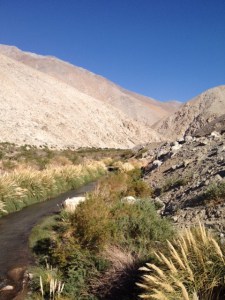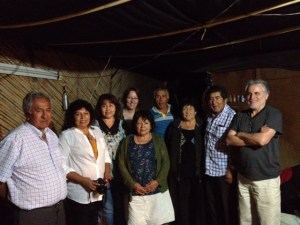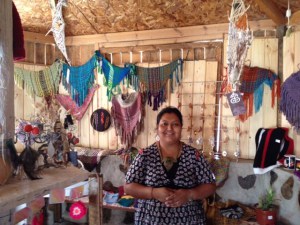30 de Septiembre de 2015
 The Huasco Valley in the arid Andes Mountains of Chile and the glacier fed river that enables cultivation. Photo by Adrienne Wiebe. |
 A meeting with Diaguita community leaders in the Huasco Valley, Chile to talk about the impact of the Pascua-Lama mine. Photo by Adrienne Wiebe. |
 Palinay, a Diaguita community member, impacted by Barrick’s Pascua Lama gold mine in the Andes Mountains of Chile. Photo by Adrienne Wiebe. |



Minería transfronteriza / Pueblos originarios / Comunidades / Pascua-Lama /
Proyecto Pascua-Lama:
Barrick vuelve a la carga: “Es una burla para las comunidades del Huasco” denuncia Lucio Cuenca director de OLCA (12/05/2025)
Las comunidades indígenas de Chile dicen “no” a Pascua Lama 2.0 (05/05/2025)
Comunidad indígena denuncia intervención ilegal en zona glaciar del ex proyecto Pascua Lama (07/04/2025)
Pascua Lama 2.0: Habitantes del Valle del Huasco movilizados contra el nuevo proyecto de Barrick Gold (22/03/2025)
¿El regreso de Pascua Lama?: organizaciones en alerta por anuncio mediático de la minera transnacional Barrick Gold (17/02/2025)
Barrick, plazos que no se cumplen y deudas que no se pagan (06/02/2025)
Rechazo al anuncio del proyecto de Barrick Gold para reposición de Pascua Lama (15/01/2025)
Encontradas reacciones dejó anuncio de nuevos sondajes de Barrick (14/01/2025)
SEA Atacama realiza visita técnica por EIA “Modificación Fase de Cierre Pascua Lama” (23/02/2024)
Dirección General de Aguas investiga denuncia sobre contaminación de ríos por proyecto minero Pascua Lama (17/02/2023)
Chile - Minería transfronteriza
SEA Atacama realiza visita técnica por EIA “Modificación Fase de Cierre Pascua Lama” (23/02/2024)
Demanda colectiva contra Barrick Gold por dar falsas declaraciones medioambientales (14/01/2023)
Pascua Lama: Corte Suprema rechaza recurso de casación y confirma fallo de Tribunal Ambiental que sancionó a proyecto minero en proceso de cierre (14/07/2022)
Evalúan avances en actividades de cierre de Pascua Lama (25/03/2022)
Comunidad logra fallo histórico de la Corte Suprema: Demuestran que Barrick Gold desobedece cierre de Pascua Lama y se ordena a las autoridades supervisarla de manera efectiva (08/02/2022)
Corte Suprema acusa a Pascua Lama de incumplir el plan de cierre y ordena fiscalización de autoridades (05/02/2022)
Denuncian a minera Barrick Gold por río que sigue contaminado al no cerrar su proyecto Pascua Lama (12/11/2021)
Acusan a Minera Barrick Gold de contaminar río en el cierre de Pascua Lama (02/11/2021)
Comunidades rechazan por engañoso el plan de cierre de Pascua Lama propuesto por Barrick Gold (28/10/2021)
No hay respuestas: Pascua Lama es denunciado por muerte de especie vulnerable, sigue funcionando pese a su clausura total y mantendría negociaciones con el SII (31/03/2021)
Minería transfronteriza
Minería de oro: Infinito Gold vs. Costa Rica ante el CIADI a tres meses de un comunicado oficial de Costa Rica omiso .... Costa Rica (16/10/2024)
Firmas y sellos falsos figuran en la aprobación de licencia ambiental de mina Cerro Blanco, señala ministra. Guatemala (24/04/2024)
La explotación de una mina de oro en la frontera entre Haití y la República Dominicana causa preocupación. Haití (17/09/2023)
Protesta en las aguas de Güija contra la minería en El Salvador y Guatemala. El Salvador (23/04/2023)
Guatemaltecos rechazan la mina Cerro Blanco a cielo abierto, que afecta ríos de El Salvador. Guatemala (19/09/2022)
Ambientalistas de Guatemala y El Salvador rechazan la minería. Guatemala (23/04/2022)
Pueblos originarios
Blanca Chancosa: “Con la llegada de los españoles, anocheció a mitad del día. Y sigue siendo de noche”. Ecuador (21/11/2025)
Llamado urgente de la comunidad internacional al cese inmediato de la represión, la militarización y el uso excesivo de la fuerza en Ecuador. Ecuador (16/10/2025)
Comunidades
La sociedad civil y el mundo académico piden a la empresa canadiense DPM Metals Inc que cierre definitivamente su proyecto Loma Larga en Ecuador. Ecuador (20/11/2025)
Invitan al webinar regional “Contar para resistir: Historias de los territorios - Desafíos de la comunicación comunitaria frente a los proyectos de muerte”. Internacional (05/02/2025)
Ver más:
Minería transfronteriza / Pueblos originarios / Comunidades / Pascua-Lama /